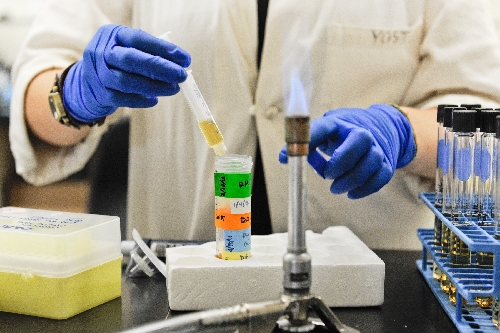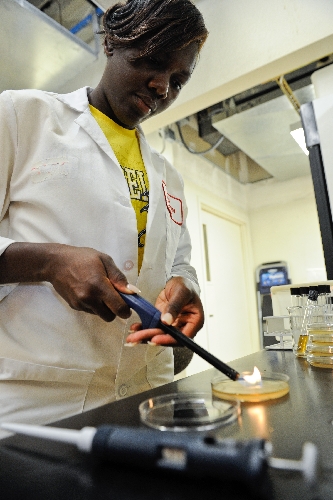UNLV researchers fight disease affecting honeybees




Two scientists who work in a lab down a maze of hallways in a building at the edge of UNLV’s campus are on the verge of stopping the human race from starving to death.
They will say that’s an exaggeration. That they and the university will not, in fact, make a billion dollars off their discovery. That they’re just furthering the cause of science.
Except, it might not be an exaggeration at all.
A third of all the food we eat was pollinated by honeybees. That includes most fruits, nuts and vegetables.
A million honeybees are trucked into California every year just to pollinate crops. A study by Cornell University estimated the value of the country’s honeybee pollination industry at $19 billion a year.
So, basically, we’d all be dead if it weren’t for the honeybee.
Which means a disease that’s wiping out honeybees is bad. Really bad.
If someone discovers something that will stop that disease, that someone is saving all human life as we know it.
Meet professor Penny Amy and graduate student Diane Yost.
These two say things like, “We’ve isolated 31 isolates of the virus,” and they use words like “pathogen” and “bacteriophage,” so we’re going to paraphrase a whole bunch here.
Amy has been at the University of Nevada, Las Vegas for 26 years. She’s a microbiologist who specializes in how microbes interact with the environment. Microbes are bacteria, viruses and other tiny organisms.
Yost is a 24-year-old student from Las Vegas who switched majors and latched onto environmental microbiology.
A couple of years ago, the professor heard a presentation on the topic of honeybees. The pathogen American foulbrood disease came up.
Amy had not heard of that.
AFB has been known about for 100 years. It is called “American” because this is where it was first discovered, but the disease is worldwide. It is the worst of the bacterial diseases that affect honeybees.
It is a bacteria that simply exists in nature. Sometimes, honeybees encounter it while out running their errands. When they return to the hive, they sometimes accidentally bring it with them.
That is how it works its way into honeybee colonies. It does not harm adult bees, but when the larvae – the babies – get infected, the bacteria settles into their gut and eats them from the inside out.
It is gross and it is deadly.
Needless to say, a beehive that can’t produce viable babies is a beehive that won’t last very long.
AFB can live in spores that settle on bee equipment for 40 years or more. If a hive gets infected, the most common solution is to burn everything. That’s how dangerous it is.
If this thing started taking out beehive after beehive, circling the planet like a monster in a Hollywood blockbuster?
Well, let us not think about that.
Let us think about science instead.
When professor Amy started thinking about AFB, she thought about how some scientists have figured out ways to kill some bacteria with viruses.
This has been going on for decades, but it’s really taken off in recent years as researchers look for ways to kill so-called “superbugs,” or bacteria that have become resistant to antibiotics.
So anyway, Amy did some more research. She wrote a grant proposal. She got it, from the U.S. Department of Agriculture.
She recruited some grad students, including Yost.
The two started collecting samples from nature, trying to find viruses in things related to bees.
They tested soil from Pennsylvania and Iowa; beeswax, that gluey stuff bees make to hold their hives together; even a tube of Burt’s Bees lip balm that Yost found while walking her dog in a park. In all, they tested 98 different things.
Turns out, they found naturally occurring strains of a virus in 31 of the samples (including, yes, the lip balm). None of those virus strains hurt humans – or, more importantly, adult honeybees.
They ran some tests. They figured out that some of those strains actually did kill the AFB bacteria.
They presented the results of their research last month to the American Society for Microbiology.
They’re in the process right now of running DNA testing to figure out which strains are which.
Once they figure that out, they’ll want to weaponize the stuff. They wouldn’t use that term, of course, but that is the goal. They want to figure out whether they can make it into a spray or something that would essentially treat infected beehives or, even better, protect beehives from ever getting infected.
If they could do that, they would stop once and for all a terrible disease that’s infecting bees all over the planet.
They could patent their discovery jointly with the university.
And everyone would walk away, satisfied that they’ve saved the planet, done good science, and made off with a billion dollars.
Contact reporter Richard Lake at rlake@reviewjournal.com or 702-383-0307.












